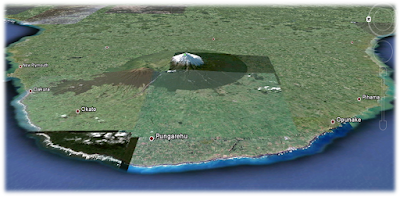“Though some, in darkness of heart, seeing their land ravished, might wish to take arms and kill the aggressors, I say it must not be. Let not the Pākehā think to succeed by reason of their guns. . . . I want not war, but they do...The government come not hither to reason, but go to out-of-the-way places. They work secretly, but I speak in public so that all may hear.”
- Te Whiti o Rongomai
What was Parihaka?
- Parihaka is a place, a village.
- Teachings from Old Testament, and the principle of non-violence.
- Many threatened hapu (sub-tribes) from North Island were attracted to the settlement and its two leaders, Te Whiti o Rongomai and Tohu Kākahi.
- South Taranaki 1860-1890.
- Resisted invasion of estate.
- Used non-violent resistance.
 |
| Taranaki as seen from Google Earth. |




